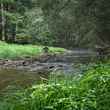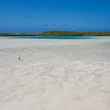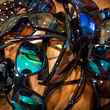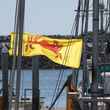I was in a bad mood, and for a gringo who’d rented a small house just across the street from the beach in a tiny Mexican fishing village just north of the border with Belize, that’s hard to fathom.
The day before, we’d dealt with a rental car company in Cancun that refused to honor the online bargain I’d found, and we got stuck with a bill that was, to put it kindly, exorbitant. With my rum budget in peril, I figured I’d return the car a week later after leaving as much of the undercarriage as I could on the speed bumps and in the potholes that pocked the road south.
But I was still pissy when we pulled into Xcalak that first afternoon. It’s the kind of pissy that only bonefish could salve. Bonefish and pure cane liquor. And maybe a torta.
We pulled into town and both of us looked at each other, our faces crossed with expressions of utter disgust.
“What is that smell?” I asked Rachel. It was almost as if the query came out in stereo, as Rachel posed the same question to me. It was a foul, fetid stench that hinted of rotting fish and the decaying leave-behinds of a Vegas buffet. I retched a little.
The culprit? Sargassum, the naturally occurring seaweed that, in normal amounts, is actually a good thing. The floating mats of algae provide cover and habitat for pelagic and inshore fish. They attract smaller fish which bigger fish eat. Sargassum has been a part of the Caribbean environment for as long as records have been kept—it was first documented in the West Indies by none other than Christopher Columbus.
But this wasn’t normal. Mats of the algae, suspended in the Caribbean by gas filled “berries” were washing ashore all along the Yucatan in amounts that were impossible to control. A good foot of it rested on the sand, and mats of it extended out into the shallow flats between the town and the reef a couple of miles offshore. The normally clear inshore water had become an algal tea. On the beach, where the seaweed had washed up, it decayed in the tropical sun. The little gas berries burst and the whole conglomeration of organic matter oozed hydrogen sulfide at nose-blistering levels.
My mood darkened even more. A week? Here? With that stench?
Yes, you can eventually become nose-blind to it. But it takes some time. And, word to the wise, don’t walk through it. You’ll get a dose of stink in your face that might make you pass out. I’m not kidding.

Sadly, this has been the case throughout much of the Caribbean since 2011. Nearly every year since, unnatural amounts of sargassum have formed in the tropical Atlantic and the Gulf of Mexico. In 2015, officials in Mexico documented the largest amount of sargassum ever recorded along the Mayan Riviera beaches. In 2018, the year I spent a week in Xcalak, that record was shattered. And, already this year, the stench of rotting sargassum is gracing the touristy beaches of Cancun, Playa del Carman and Tulum. And, I suspect, my favorite little fishing grotto, Xcalak.
This, it would appear, is the new normal.
But why?
Scientists studying the phenomenon say the jury is still out, but fairly firm hypotheses exist, as put forth in the 2017 scientific report, “On the potential causes of the recent Pelagic Sargassum blooms events in the tropical North Atlantic Ocean,” published in the scientific journal, Biogeosciences Discussions. Simply put, ocean conditions now create a perfect storm for seaweed blooms. Excess nitrogen and phosphorus from fertilizers entering the ocean from inland sources combine with climate change-induced changes to ocean currents, warmer sea surface temperatures and hot, sunny summers that nurture the algae into full-on mats that shade the ocean floor and eventually pile up in impossible amounts on seaside beaches.
As more and more of the tropical rainforest is razed in favor of agricultural fields, the demand for fertilizer is more pronounced. Then, of course, it rains, and the nitrates and phosphates in that fertilizer is carried down rivers like the Amazon and the Orinoco in Brazil and the Congo in west Africa and out to sea. The nutrient load from the Mississippi River is also a likely contributor to the sargassum bloom.

Other factors contribute, too. Scientists have also put forth the notion that African atmospheric dust—the result of centuries of questionable agricultural practices combined with years of drought—also contributes to the bloom.
It would be nice to just write it off as a natural event, but science is quickly proving otherwise.
And, sadly, the impacts go beyond the rotten-egg smell on the beaches of the Mayan Riviera. The mats of sargassum can smother sea turtle nests on sandy beaches. Those mats that don’t make it to land sink and decay over already fragile coral ecosystems in the Caribbean. As with any large algal bloom, sargassum robs the water of oxygen, which impacts fish … and fishing. In May 2017, sargassum is blamed for a massive fish kill north of San Pedro, Belize. Photos in the article from the San Pedro Sun depict dead bonefish, and permit, needlefish and pufferfish were also documented as killed during the event.
And it’s certainly not going unnoticed by the governments in Mexico and across the Caribbean. The government of Quintana Roo, where the Mayan Riviera is situated, called the sargassum one of the biggest negative outcomes that “climate change has caused for the world.” A symposium conducted at the University of the West Indies in Jamaica in 2015 determined that cleaning the sargassum would take $120 million and 100,000 people. And it would likely just come back, because cleaning it up off the beaches doesn’t solve the problem at the source (or sources).
Aside from the rental car fiasco (I parked it under a sappy fruit tree while I was in Xcalak—take that!), the mood in Xcalak did eventually improve, but that’s because we found ways to work around the seaweed. We found bonefish in Chetumal Bay, which wasn’t impacted as greatly as the flats on the ocean side. But it was there, and our guide was quick to tell us that this wasn’t “normal.”
Except, of course, that, from here on out, it likely will be.
































Comments